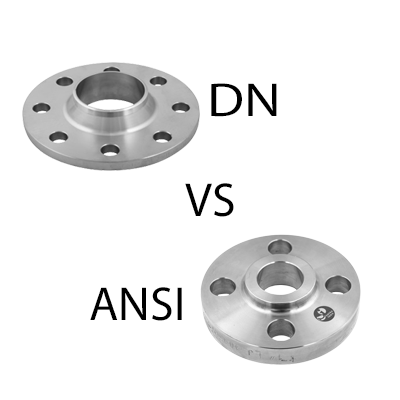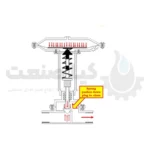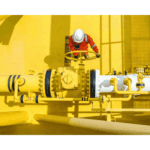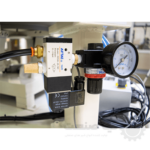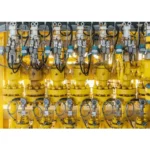Flanges are an important component in piping systems that are used to connect pipes, valves, pumps and other equipment. When choosing a flange, two main standards should be considered: DN (nominal dimension) and ANSI (American National Standards Institute).
While both have commonalities, there are some key differences to understand when choosing between DN vs. ANSI flanges.
This article compares DN and ANSI flanges in detail to help you make the right choice.
Flanges provide a method of connecting pipes and conveying fluids or gases with bolts and nuts with gaskets between them to seal the connection.
They are used in many applications from the oil and gas industry to food and beverage processing, power plants, and more.
There are two main international standards for flange dimensions and ratings:
DN/ISO) – dimensional name (European standard)
ANSI – American National Standards Institute (American Standard)
While both follow the same design principle, there are differences in dimensions, pressure ratings, finishes, and screw patterns that make them interchangeable.
Familiarity with DN and ANSI flanges will ensure you choose the right flanges for your piping system.
read more: fisher Vee-ball v150
What Does ANSI Mean?
ANSI stands for the American National Standards Institute. It’s a private, non-profit organization that oversees the development of standards for products, services, processes, and systems in the U.S.
When we talk about an ANSI flange, we’re referring to a flange that meets specific ANSI standards for dimensions, pressure ratings, materials, and other technical criteria. These standards ensure consistency, compatibility, and safety across a wide range of piping systems.
What Is a Flange Anyway?
A flange is a mechanical component used to connect pipes, valves, pumps, and other equipment. It usually involves a flat or rounded rim that bolts onto another flange or fitting, creating a tight, leak-proof seal. Flanges are commonly used in pipelines to allow for easy inspection, cleaning, or modification of the system.
Key Features of ANSI Flanges
Here’s what makes ANSI flanges distinct:
-
Standardized Dimensions: ANSI flanges follow standardized sizes, which means a 4-inch ANSI flange from one manufacturer will match a 4-inch ANSI flange from another. This interchangeability is essential for large-scale projects.
-
Pressure Classes: They come in various pressure classes (like 150, 300, 600, etc.), which indicate the maximum pressure the flange can handle. The higher the number, the stronger the flange.
-
Materials: ANSI flanges can be made from stainless steel, carbon steel, cast iron, aluminum, or even plastic—depending on the application and the type of fluid being transported.
-
Face Types: They come in several face types, including raised face (RF), flat face (FF), and ring-type joint (RTJ). Each type serves different sealing purposes.
Understanding the Difference Between DN and ANSI Flanges
In the world of industrial piping systems, flanges serve as a crucial interface to connect pipes, valves, pumps, and other essential components. They provide not only mechanical support but also a tight seal for transporting fluids and gases safely. Among the various flange standards globally, two commonly used systems dominate: DN (Diamètre Nominal) and ANSI (American National Standards Institute). While these standards may seem similar at first glance, they are fundamentally different in several critical ways.
This guide is designed to provide you with clear, technical insight into the distinctions between DN vs. ANSI flanges, helping you choose the right type for your system—whether you’re designing a refinery pipeline or upgrading your facility’s processing line.
What Are ANSI Flanges?
ANSI flanges adhere to standards defined by the American National Standards Institute, a highly respected non-profit organization in the United States. ANSI oversees and regulates specifications for countless industries, including manufacturing and engineering. Flanges that meet ANSI standards are designed with imperial measurements, using inches to define sizes and pressure ratings.
Key Attributes of ANSI Flanges:
-
Standardized Dimensions: A major strength of ANSI flanges is their dimensional uniformity. For instance, a 6″ Class 150 ANSI flange will have consistent dimensions no matter who manufactures it.
-
Pressure Ratings: ANSI flanges are categorized by pressure classes—Class 150, 300, 600, etc.—which correlate with the maximum pressure they can handle at a given temperature.
-
Material Range: These flanges are made from a broad range of materials including A105 (carbon steel), F316L (stainless steel), and even plastic, depending on the application.
-
Face Types: Common face configurations include Raised Face (RF), Flat Face (FF), and Ring Type Joint (RTJ), each suitable for specific sealing and pressure requirements.
-
Common Types: These include weld neck, slip-on, blind, socket weld, threaded, and lap joint flanges, tailored for various pressure, temperature, and maintenance demands.
What Are DN Flanges?
DN stands for Diamètre Nominal, a term originating from European standards. Unlike ANSI, DN flanges follow ISO/EN norms and are specified using metric units—primarily millimeters. The most relevant standard for DN flanges today is EN 1092-1, which has largely replaced older DIN standards across Europe and many international markets.
Noteworthy Features of DN Flanges:
-
Metric-Based Sizing: Sizes like DN 50, DN 100, and DN 200 correlate approximately to the inner diameter of the corresponding pipe in millimeters.
-
PN Ratings: DN flanges are classified by PN (Pressure Nominal) ratings—PN10, PN16, PN25, etc.—which denote the pressure capacity in bar.
-
Material Specifications: Common materials include P250GH (carbon steel), 1.4408 (stainless steel), and other ISO-based alloys. These materials are standardized under European norms.
-
Flange Faces: EN 1092-1 allows for Type B1 and Type B2 facings—roughly analogous to ANSI’s RF and FF options.
-
Application Scope: DN flanges are prevalent across Europe, Asia, the Middle East, and globally in any system that adopts ISO-based designs.
Key Differences Between DN and ANSI Flanges
To understand the critical distinction between these flange systems, we must compare specific parameters:
| Feature | DN Flange | ANSI Flange |
|---|---|---|
| Measurement Unit | Metric (mm) | Imperial (inches) |
| Standard | EN 1092-1 | ANSI B16.5 |
| Pressure Rating | PN (bar) | Class (psi) |
| Bolt Circle | Based on DN size | Based on Class rating |
| Common Materials | P250GH, 1.4408 | A105, F304, F316 |
| Interchangeability | Not interchangeable | Not interchangeable |
| Flange Face Type | B1, B2 | RF, FF, RTJ |
An example: DN 100 (approx. 4-inch bore) ≠ ANSI 4″ Class 150, because while they may serve similar roles, their bolt circle diameters, pressure limits, and materials vary.
Why Interchangeability Isn’t Feasible
A common mistake among engineers and procurement professionals is to assume DN and ANSI flanges can be swapped or welded together. Unfortunately, their bolt hole arrangements, thickness, and pressure capacities are misaligned. Attempting to match them may result in:
-
Gasket failure
-
Uneven load distribution
-
Leaks and corrosion
-
Pipe misalignment
-
Costly shutdowns or safety hazards
For example, a DN 150 PN16 flange and a 6” Class 150 ANSI flange may appear similar in size, but their screw circle diameters, hole spacing, and material compatibility prevent a secure, leak-proof connection.
Which Flange Standard Should You Use?
Your decision depends on geographic location, regulatory standards, and the type of system you’re installing or maintaining.
-
Use DN flanges if you’re working in regions governed by EN/ISO standards—such as the EU, Middle East, or Asia.
-
Use ANSI flanges in North America or where ASME B16.5 or B16.47 are required.
Consistency is key. Mixing standards in a system introduces compatibility issues and undermines safety and performance.
Final Thoughts
Understanding the distinctions between DN and ANSI flange standards is essential for engineers, designers, and procurement teams involved in industrial piping systems. While both serve the same functional purpose, their technical specifications, dimensional standards, pressure ratings, and material classifications differ significantly. Choosing the wrong type can lead to significant risks—including equipment failure, leaks, and expensive rework.
By aligning your selection with the appropriate regional standard and ensuring compatibility throughout your system, you’ll maximize system reliability, safety, and efficiency—a principle at the heart of sound engineering practice.
Common Types of ANSI Flanges
Here’s a quick breakdown of the most common ANSI flange types:
| Flange Type | Description |
|---|---|
| Weld Neck Flange | Designed to be butt-welded to a pipe, offering high strength and resistance to stress. Ideal for high-pressure applications. |
| Slip-On Flange | Slides over the pipe and is then welded. Easier to align and install, typically used in low-pressure systems. |
| Blind Flange | Used to seal off the end of a pipe or vessel. Great for pressure testing or isolating sections of a pipeline. |
| Socket Weld Flange | The pipe fits into a socket inside the flange and is then fillet welded. Often used for smaller-diameter high-pressure pipes. |
| Threaded Flange | Screwed onto a threaded pipe. No welding is needed, making installation quicker and easier. |
| Lap Joint Flange | Used with a stub end, allows for easy alignment. Common in systems that require frequent dismantling. |
What Is a DN Flange?
When working with pipelines or industrial systems, you’ll often hear the term DN flange thrown around.
If you’ve been wondering what it means or how it compares to other flange types, you’re in the right place.
This guide breaks it down clearly, without overwhelming you with overly technical terms—while still giving you all the important info.
What Does DN Mean in a Flange?
Let’s start with the basics.
DN stands for Diamètre Nominal (or Nominal Diameter in English). It’s a standard used internationally (mostly under ISO and EN norms) to define the approximate inner diameter of a pipe, in millimeters.
Unlike inches in the American system (like NPS for “Nominal Pipe Size”), DN uses whole numbers and sticks to the metric system. So when you hear someone mention a “DN 100” flange, they’re talking about a flange that fits a pipe with a nominal diameter of 100 mm.
What Is a DN Flange?
A DN flange is a type of pipe flange that conforms to European and international standards—mainly EN 1092-1 (which replaced the older DIN standards). These flanges are widely used across Europe, the Middle East, Asia, and increasingly in global projects where ISO standards are preferred.
Just like any other flange, a DN flange is used to connect pipes, valves, pumps, and other components in a piping system. It creates a secure, leak-tight seal and allows for easier maintenance and access.
Key Features of DN Flanges
Here’s what makes DN flanges distinct:
-
✅ Metric-Based Sizing: All sizes are based on millimeters (DN 15, DN 50, DN 200, etc.), making them consistent with metric piping systems.
-
✅ International Standards: They typically follow EN 1092-1, ensuring global compatibility and high manufacturing standards.
-
✅ Pressure Ratings: DN flanges are rated by PN (Pressure Nominal) values, such as PN 10, PN 16, PN 40, etc. These indicate the max pressure (in bar) the flange can handle.
-
✅ Material Variety: Available in carbon steel, stainless steel, ductile iron, brass, and even plastic, depending on your needs.
-
✅ Face Types: Includes types like raised face (RF), flat face (FF), and tongue and groove, depending on the sealing requirements.
Key differences between DN and ANSI flanges
When evaluating DN versus ANSI flanges, the following factors should be compared:
Dimensions
DN flanges are based on the nominal pipe size with an increase in joint diameter.
ANSI flanges have standard dimensions in inches that are not directly related to pipe size.
This means that a DN 100 flange aligns with a 100mm pipe, while a 4″ ANSI flange has an approximately 4.5″ bore.
DN flanges use standards while ANSI uses country units.
read more: Samson 3241
Pressure rating
DN flanges use the PN rating (maximum pressure in BAR at a given temperature).
ANSI flanges use class ratings (maximum psi pressure based on material strength).
For example, flange DN150 = PN16 ANSI flange “6 150# in pressure control capability
Flange appearance
DN flanges use form B1 or B2 covers.
ANSI flanges use raised face (RF) or flat face (FF) facings.
B1 is similar to RF, while B2 is comparable to FF.
The cover must match for proper sealing.
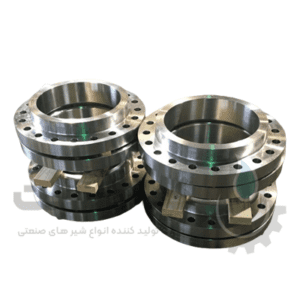
Screw circles
DN screw holes are placed based on the nominal diameter.
ANSI bolt circles are based on flange class ratings.
The bolt holes do not align between the two styles.
material
DN flanges use metric based materials – P250GH, 1.4408 etc.
ANSI uses US/Imperial grades – A105, A182, F316L, etc.
The material must be equal to the required temperature and pressure.
As you can see, DN vs. ANSI flanges have many differences that make them not interchangeable.
Mixing the two often leads to leaks, damage, and other problems.
To compare DN versus ANSI standard flange sizes, check out the table below:
DN Flange Nominal Pipe Size ANSI Flange
DN15 15 mm 1⁄2″
DN20 20 mm 3⁄4″
DN25 25 mm 1”
DN32 32 mm 1⁄4”1
DN40 40 mm 1⁄2″1
DN50 50 mm 2″
DN65 65 mm 1⁄2”2
DN80 80 mm 3″
DN100 100 mm 4”
DN125 125 mm 5”
DN150 150 mm 6”
DN200 200 mm 8”
DN250 250 mm 10″
DN300 300 mm 12″
DN350 350 mm 14″
DN400 400 mm 16″
It covers the most common DN vs. ANSI flanges up to 16″ in size. This only provides a rough comparison
Exact dimensions may vary. Verify specifications before replacing ANSI and DN flanges.
read more: samson t2595
DN vs. ANSI Flange FAQ
Some frequently asked questions about DN vs. ANSI flanges are:
Are DN and ANSI flanges interchangeable?
No, DN and ANSI flanges are not directly interchangeable due to differences in dimensions, ratings, finishes and materials. Attempting to mate a DN flange with an ANSI flange will result in a mismatch.
Can you use DN flange on ANSI pipe?
No, the different dimensions mean that the DN flange does not match the ANSI pipe size correctly.
They are designed as systems to match DN flanges to DN pipes and ANSI to ANSI pipes.
How to convert DN to ANSI flange size?
There is no direct conversion between DN vs. ANSI pipe sizes.
The chart above provides approximate equivalents for typical DN and ANSI nominal flange sizes. Always check actual measurements, dimensions can vary in standards.
Should I use DN or ANSI flanges?
If your piping system is located in locations with ISO standards (Europe, Middle East, Asia), DN flanges are probably required. For North America using ANSI standards, ANSI flanges will be the typical choice.
Use the same standard as the rest of your tubing for proper fit and performance.
Can you weld DN and ANSI flanges together?
You should never butt DN vs. ANSI mismatched flanges.
Different screw circles don’t line up, resulting in gaskets that don’t fit properly, leak, and cause possible pressure damage.
Result
When it comes to choosing flanges, it’s important to understand the key differences between DN and ANSI standards.
Mismatched flanges can lead to leaks, equipment damage, and costly repairs.
By comparing dimensions, pressure ratings, finishes, and materials, you can ensure you choose the right DN or ANSI flange every time.
Kiasanat is a supplier of industrial valves, control valves, pressure relief valves, ball valves, butterfly valves, pneumatic valves, globe valves, etc.

